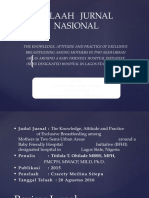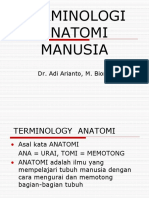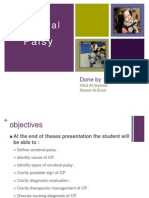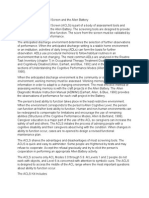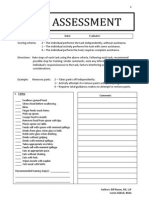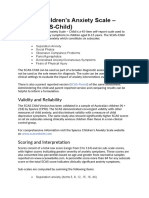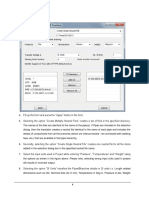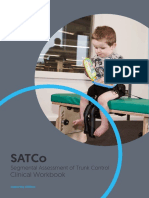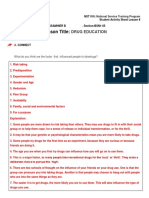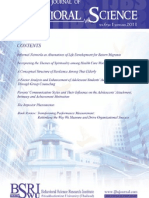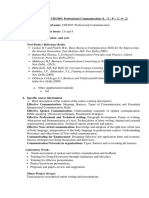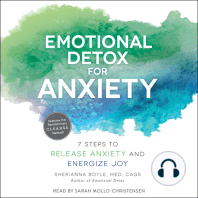Professional Documents
Culture Documents
An Exploration of The Impact of Parenting On The Sleep Patterns of Children With ADHD
Original Description:
Original Title
Copyright
Available Formats
Share this document
Did you find this document useful?
Is this content inappropriate?
Report this DocumentCopyright:
Available Formats
An Exploration of The Impact of Parenting On The Sleep Patterns of Children With ADHD
Copyright:
Available Formats
Volume 8, Issue 5, May – 2023 International Journal of Innovative Science and Research Technology
ISSN No:-2456-2165
An Exploration of the Impact of Parenting on the
Sleep Patterns of Children with ADHD
Tri Budi Santoso*
Department of Occupational Therapy, Surakarta Health Polytechnic of Ministry of Health,
Indonesia
*Corresponding author: Tri Budi Santoso, Ph.D. OT, Senior Lecturer, and a Researcher,
The Department of Occupational Therapy, Surakarta Health Polytechnic (Campus II), Jl. Kapt.
Adisumarmo, Tohudan, Colomadu, Karanganyar, Surakarta Central Java, Indonesia 57173,
Abstract:- et al., 2005). Caregivers should be able to recognize the
Background: The type of parenting given to a child with conditions that cause sleep problems in children before
ADHD will affect the child's sleep patterns in their daily implementing parenting (Aafjes, 2021) because sleep
life. This study will explore the impact of parenting on the problems that are not addressed adequately by caregivers can
sleep patterns of children with ADHD. reduce sleep quality and quantity (Noble, 2012; Raphael-
Objective: This study aimed to explore the influence of Leff, 2018). According to Dorris et al. (2008) & Espie
parenting on the sleep patterns of ADHD children. (2002), the application of parenting, primarily before
Method: This study was conducted using a bedtime, was found to help reduce sleep problems.
phenomenology approach. Data were collected using
semi-structured interviews with eight participants of In a Study conducted by Sciberras (2017), bedtime
primary caregivers of children with ADHD. Qualitative habits, especially sleep hygiene, are related to the duration
methods were applied using in-depth interviews. and onset of sleep in the same direction as decreased daytime
Interview data were analyzed using thematic analysis. sleepiness. At the same time, total care from caregivers is
Results: This study resulted in 3 themes based on linked to reduced sleep resistance (Sciberras, 2017). Warmth
parenting patterns that affect sleep patterns that have and consistency during caregiving can also be associated
been identified in this study, namely: Caregiver parenting, with decreased sleep anxiety and parasomnia (Sciberras,
type of parenting, and sleep pattern problems in ADHD 2017), which is related to a study done by Nobel (2012),
children. which focuses on aspects of parenting that affect the
Conclusion: Occupational therapists should pay attention development of sleep problems in children with ADHD.
to children's sleep patterns based on caregivers' Nobel (2012) also found that increased conflict between
parenting patterns to find the cause of sleep problems in caregivers and children before bedtime was found to increase
children with ADHD to improve children's sleep quality due to low sleep routines. Therefore, implementing habits
and general well-being. based on parenting can predict children's future sleep
problems (Allen et al., 2016; Combs-Orme et al., 2011).
Keywords:- Sleep Pattern; Parenting Style; Caregiver;
Children with ADHD Specifically, permissive parenting is associated with
prolonged sleep latency (Shetty, 2022; Tu, 2018).
I. INTRODUCTION Authoritarian parenting makes children uncomfortable
because caregivers do not facilitate distractions (Noble,
Parenting affects the development of sleep problems in 2012). The quality of sleep of children with authoritative
children with ADHD (Noble, 2012). The role of caregivers in parenting is not associated with anxiety (Cavallina, 2015;
the development of children's sleep ability can be seen in the Tyler, 2019). In contrast, authoritarian parenting was found
sleep problems experienced by children (Tikotzky, 2017). to cause pre-sleep anxiety and problems related to sleep
Because in ADHD children, problems in sleep quality come efficiency (King, 2016; Tyler, 2019). While internalizing and
from behavior, parenting style, bedtime routines and habits, externalizing behaviors are associated with the development
child-caregiver interactions, and the environment (Bathory, of sleep problems in neglectful parenting (McPhie et al.,
2017; Martin, 2019; Tikotzky, 2017). According to Wilson 2014; Turner et al., 2020). Neglectful parenting during sleep
(2013), sleep problems that arise due to parenting are sleep is uncomfortable and tends to wake up quickly (King et al.,
pattern problems caused by parental behaviors and nighttime 2016). In addition, King et al. (2016) also found that bad
activities. In the sleep environment, bedtime habits such as sleeping habits will continue to be repeated in permissive
limit-setting and co-sleeping can affect sleep hours and sleep parenting.
patterns (Bordeleau et al., 2012; Hale et al., 2018).
This study explores the experience of applying
Caregivers generally do not realize the impact of caregiver parenting to sleep patterns in ADHD children.
parenting on the development of their children's sleep Research related to parenting patterns that impact the sleep
problems (Bussing et al., 2003; Sung et al., 2008; Weckerly patterns of ADHD children has been carried out in many
IJISRT23MAY2360 www.ijisrt.com 2684
Volume 8, Issue 5, May – 2023 International Journal of Innovative Science and Research Technology
ISSN No:-2456-2165
previous studies. However, based on the literature review, no from Surakarta and lives with the child, (d) the caregiver is
research examines the impact of the four types of parenting willing to be a respondent.
simultaneously on sleep patterns. So there is a need for a
study that can compare the problems of children's sleep The research was conducted at Yayasan Pembinaan
patterns with ADHD based on the four types of parenting in Anak Cacat (YPAC) Surakarta. This study's initial data
Indonesia. collection stage was distributing invitations to potential
respondents. Invitations for research participants were sent to
II. METHOD primary caregivers through the YPAC Surakarta clinic. The
researcher informed the participants that participation was
Participants voluntary. Researchers received informed consent from
The participants in this study totaled eight primary participants who were willing to become research
caregivers of children consisting of mothers, grandmothers, respondents. The following process was an initial screening
and aunts. All participants were primary caregivers with an of the general condition of the family and child before
intensity of 10-12 hours daily. Participants' occupations were collecting data on sleep patterns. Data was collected using
homemakers, office workers, and household assistants. the semi-structured interview research method 2-3 times. The
interview protocol conducted the Semi-structured interviews
Primary caregivers were recruited voluntarily using to maintain the accuracy of the data to be collected.
purposive sampling. Participants were selected based on the Researchers documented the results of the interview using a
following inclusion criteria: (a) the caregiver is the primary voice recorder. Research permission was obtained from the
caregiver who cares for ADHD children aged 5-12 years, (b) YPAC Foundation Surakarta Ethics Committee.
the caregiver can speak Indonesian, (c) the caregiver comes
Table 1. Caregiver Characteristics
Participants Gender Age, yr Caregiver Diagnosis Jobs Education
P1 Female 58 Aunt ADHD Homemaker High School
P2 Female 59 Aunt ADHD Office workers High School
P3 Female 40 Mother ADHD Homemaker Bachelor's Degree
P4 Female 32 Mother ADHD Homemaker associate degree
P5 Female 43 Mother ADHD Homemaker associate degree
P6 Female 39 Mother ADHD Homemaker associate degree
P7 Female 65 Grandma ADHD Homemaker High School
P8 Female 67 Grandma ADHD Homemaker High School
Data Collection Data Analysis
The data collection technique used in this research is in- The approach used is Thematic Analysis. Lochmiller
depth interviews so that participants' experiences can be told (2017), Braun (2013; 2019), & Liamputtong (2019) state that
naturally. Therefore, the researcher chose the semi-structured the sequence of steps to analyze qualitative data with
interview form. Semi-structured interviews were chosen thematic analysis is as follows: First round pass
because exploratory studies require themes to emerge freely (Familiarizing the Data); Entering codes in subcategories and
and naturally (Blandford, 2013; Roulston & Choi, 2018). categories or themes (Generating Initial codes, Searching for
Interviews were conducted once with a total duration of 40- Themes); Re-Examine Code; Review Themes and Define
60 minutes per participant. Five main questions related to the Themes; Transforming code categories into narrative text.
application of parenting described the type of caregiver's
parenting and the problems caused by the caregiver's The credibility and objectivity tests are two types of
parenting. data analysis used in this research. Researchers conducted
triangulation and member checking in the credibility test and
To increase data saturation, researchers conducted used audit trail and reflexivity in the objectivity test. Source
additional interviews related to parenting patterns applied by triangulation is comparing and cross-checking the degree of
caregivers. To test the credibility of the interview data, the data confidence through different times and tools (Speziale,
researcher conducted triangulation. The triangulation used in 2011; Tabatabaee, 2013). Theoretical triangulation tests data
this study is theoretical triangulation and source credibility by comparing the data obtained with previous
triangulation. The theoretical triangulation is done to double- theories (Tabatabaee, 2013). The participants' interviews
check the data obtained and compare it with several theories were recorded using a voice recorder to maintain the
(Tabatabaee, 2013), While source triangulation is done by accuracy of the data. After all themes and sub-themes were
checking the code and reconfirming the data on the sample at confirmed through member checking and reflexivity on each
different times (Tabatabaee, 2013). participant. Based on the study's results, the most changed
sleep patterns were found in authoritarian parenting. The data
is then matched with the theory that has been found
previously.
IJISRT23MAY2360 www.ijisrt.com 2685
Volume 8, Issue 5, May – 2023 International Journal of Innovative Science and Research Technology
ISSN No:-2456-2165
III. RESULT the child's situation and environment also changed. As one
participant (R4) stated as follows: "...depends on the child
This research resulted in 3 themes and eight sub- again. If the sleeping time is right, the child is not too
themes. The first theme is Caregiver Parenting with sub- fussy..." (R4)
themes of the Application of Caregiver Parenting and the
Application of Sleep Pattern Based on Parenting. The second Implementation of Sleep Patterns Based on Parenting
theme is Types of Parenting with sub-themes of Implementing a fixed sleeping pattern is generally
Authoritarian Parenting, authoritative Parenting, Permissive already present in children with authoritative parenting.
Parenting, and Neglectful Parenting. The third theme is Sleep Consistent sleep habituation in children is accompanied by
Pattern Problems in ADHD Children with sub-themes Sleep negotiation skills in children's sleep patterns. Meanwhile, the
Pattern Problems and Causes of Sleep Pattern Problems. application of sleeping patterns that are still changing is
related to the child's condition and family conditions.
Table 2: Themes and Subthemes Caregivers recognize the need of children who cannot
NO THEME SUBTEMA understand the sleep patterns applied to be the main obstacle.
1 Caregivers' Implementation of Caregivers'
Parenting Parenting Type of Parenting
Implementation of Sleep Patterns The grouping of parenting types is based on Baumrind's
Based on Parenting parenting pattern (Baumrind, 1991; 1997; 2013; 2019) and
2 Type of Parenting Authoritarian Parenting supporting parenting theories. The results of the interviews
Authoritative Parenting were deduced using the reflexivity method so that they could
Permissive Parenting emerge themes freely but still follow the guidelines for the
Neglectful Parenting aspects of parenting that have been determined.
3 Sleep Pattern Sleep Pattern Problems
Problems in Causes of Sleep Pattern Problems Authoritarian Parenting
ADHD Children Based on the interview results, by looking at aspects of
parenting, the level of responsiveness of authoritarian
Caregivers' Parenting parenting is low. The caregiver's ability to validate emotions
in children is low, and behavior is more suppressed by strict
Implementation of Caregivers' Parenting and firm upbringing. A challenging and healthy attitude is
Based on this study, caregiver parenting is seen manifested in behavioral control of children's rules and
qualitatively by looking at the fulfilled aspects. In general, conduct. Children are expected to obey the rules and orders
parenting provided directly has different ways of application of the caregiver. This also leads to the imposition of
depending on the caregiver's character, the provision of rules, punishment on children's behavior that is considered deviant.
and the consistency of the parenting application. The diverse Discipline can be verbal and physical. As stated by one
caregiver characters recognized by caregivers can lead to participant (R4) as follows:
various parenting outcomes. For example, harsh feelings can
reduce oppositional behavior in children. Meanwhile, "...Yes, not often; for example, if you cry and do
caregivers must have a solid character to control behavior not stay quiet, you have also been yelled at..." (R4)
psychologically but still follow the child. Finally, gentle and
heartless caregiver characters are recognized to make Punishment can create a minimal and tenuous
children's behavior change. relationship and make children reluctant to the caregiver.
Caregivers recognize that parenting aims to make children
The provision of rules is generally related to the better individuals, so they do not prioritize emotional
disciplinary and control aspects of parenting. The ability to closeness. Another aspect that can reduce closeness is
be consistent and disciplined with regulations is related to communication. Communication is one-way and aims to
authoritative and authoritarian parenting, but negotiation is provide direction.
more prevalent in authoritative parenting. On the other hand,
low consistency in rules is related to permissive parenting. Authoritative Parenting
Caregivers with permissive parenting slowly tried to be Responsiveness in this parenting pattern is good
consistent with the regulations compared to caregivers with because it prioritizes parenting with inductive methods.
neglectful parenting. Caregivers explain more limits openly with reasons that are
acceptable to the child. The inductive approach pays attention
Two types of outcomes of the influence of caregiving to the child's opinion by negotiating freely. However, there
on sleep patterns were found. First, caregivers with consistent are still limits so that the application of rules is more flexible
implementation recognized the impact of implementing but still according to the purpose of parenting. As one
routines on sleep patterns. Although some caregivers admit participant (R3) stated as follows:
they have not seen direct results, there is still hope from the
habituation of sleep patterns. Meanwhile, caregivers who still "...If it makes sense, he will not ask until he cries
doubt the influence of parenting on sleep patterns recognize out loud..." (R3)
the obstacles in the child's condition. Participants recognized
the possibility that the impact of parenting could be seen if
IJISRT23MAY2360 www.ijisrt.com 2686
Volume 8, Issue 5, May – 2023 International Journal of Innovative Science and Research Technology
ISSN No:-2456-2165
The goal of behavior formation is controlled by verbal latency. Sleep efficiency problems are related to the child's
and psychological control. Caregivers admit that children are ability to wake up during sleep. Caregivers admit that
more comfortable when verbal control also pays attention to children often wake up at night, especially children with high
the child's willingness and ability to digest rules in behavior hyperactivity. Children quickly wake up during the day in a
formation. Children have self-control but remain within noisy or crowded environment. The problem of sleep
reasonable limits by the caregiver's parenting goals. duration is related to the child's changing sleeping hours and
Directions are given relatively to all family members so that the child's uncertain sleeping hours. Children's sleeping hours
an expected opinion results in comfort and closeness between change due to drowsiness and the caregiver's ability to
family members. prepare children's sleep time. The caregiver's ability to
prepare for the environment also affects sleep onset.
Permissive Parenting Children's uncertain sleeping hours are also influenced by
The responsiveness of this parenting pattern is the activities and opportunities to sleep outside the usual sleep
highest of other parenting patterns because caregivers schedule. The problem of latency is related to the difficulty
prioritize a sense of comfort in parenting. This is realized by of drowsiness in children for no apparent reason. Caregivers
applying rules that follow the child's condition. The child's admit that children still have difficulty falling asleep when
condition is an excuse for caregivers not to be strict during the routine and sleeping environment have been adopted.
parenthood. As stated by one participant (R5) as follows: Caregivers also recognize that children do not get sleepy
"...I did not push him because he is so easily quickly when they do not feel tired. As one participant (R7)
angered his emotions are not stable..." (R5) stated as follows:
Limits on rules are recognized as low so that the "...If I am not tired, I do not sleep..." (R7)
caregiver monitors rather than controls the child. The purpose
of monitoring is to keep the child within safe boundaries, but Sleep quantity problems consist of sleep onset
the child still feels comfortable. Caregivers mostly insomnia, actual sleep problems, and sleep deprivation.
understand the child's situation through emotional validation. Children with sleep-onset insomnia will sleep faster with the
Emotional validation is recognized by caregivers to be given application of routines. Meanwhile, children who do not have
with the direction of communication that adjusts the child's a pattern will experience limit-setting insomnia. Caregivers
condition. For example, the child will be invited to discuss with children who experience actual sleeping problems admit
when the child's emotions are stable, while the child will be that children will wake up quickly and tend to be sensitive to
calmed more when emotions are unstable. This unwittingly the surrounding environment during sleep. Co-sleeping is
causes children to feel uncomfortable with strangers and recognized to help children be calmer and not promptly wake
more likely to choose to socialize. As a result, the child is up during sleep. Children with sleep deprivation have various
only close to the caregiver. problems, such as feet that cannot stay still and delayed
bedtime due to high hyperactivity.
Neglectful Parenting
Responsiveness in this parenting pattern was the lowest In particular, caregivers with authoritarian parenting
compared to other parenting patterns. This is reflected in the recognized sleep problems, especially problems with sleep
caregiver not paying attention to the child's needs and desires efficiency and latency. The child had difficulty falling asleep
during care. Late developmental abilities are also not for no apparent reason. Although a sleep schedule had been
recognized by the caregiver. Caregivers are not fully set, sleepiness came at different times and sometimes outside
involved in parenting, so they tend to apply rules in an the plan. Meanwhile, caregivers with permissive parenting
inconsistent manner and do not have clear boundaries. follow the child's sleepiness. As a result, the schedule
Support is only provided instrumentally because the changes according to the child's condition. In neglectful
caregiver focuses only on the child's growth. Caregivers need parenting, the sleep schedule will improve when the
parenting assistance to help children's development and caregiver provides care. The child sleeps faster when the
growth. As stated by one participant (R2) as follows: caregiver accompanies the child to sleep. However, the
"...the mother is like that, sis. If she has a helper caregiver will allow the child to stay awake at night due to
or a babysitter, I do not hand it over..." (R2) fatigue after work.
Another thing that can reflect neglectful parenting is Causes of Sleep Pattern Problems
communication skills. One-way communication causes The first cause of sleep problems in ADHD children is
children's emotions not to be validated and creates an high hyperactivity. High hyperactivity at night causes
attention-seeking attitude in children. children to experience delayed sleep. While hyperactivity
during the day and night makes children lack nap time. The
Sleep Pattern Problems in ADHD Children second cause of sleep problems in ADHD children is
changing schedules and activities. The plan will temporarily
Sleep Pattern Problems change when the child is in an unusual situation, such as a
Children's sleep pattern problems based on the type of family event or recitation. In addition, the schedule
problem can be divided into sleep quality problems and sleep temporarily varies according to the child's drowsiness caused
quantity problems. Sleep quality problems consist of by fatigue, body condition after bathing, and satiety. Whereas
problems with sleep efficiency, sleep duration, and sleep
IJISRT23MAY2360 www.ijisrt.com 2687
Volume 8, Issue 5, May – 2023 International Journal of Innovative Science and Research Technology
ISSN No:-2456-2165
permanently, sleep schedules can change due to school Type of Parenting
schedules. As one participant (R1) stated as follows:
"...If there is a family event, he never takes a nap. So Authoritarian Parenting
many families come..." (R1) Authoritarian parenting is defined as parents exhibiting
high demands and low responsiveness levels (Baumrind,
The third cause of sleep problems in ADHD children is 1971; Steinberg, 2001). The lack of closeness and warmth
unknown to the caregiver. Caregivers unaware of the cause during parenting manifests in the caregiver's strict and harsh
of sleep problems will continue to try to implement a sleep character (Alloy et al., 2006; van Voorhees et al., 2008).
routine so that the child falls asleep quickly. Hard and firm attitudes are manifested in behavioral control
over children's rules and behavior (Kuppens & Ceulemans,
IV. DISCUSSION 2019). Children are expected to obey the rules and orders of
the caregiver (Trifan et al., 2014; Kuppens & Ceulemans,
Caregivers' Parenting 2019). This has also led to punishing children's behavior that
is considered oppositional (Durrant et al., 2003; Trifan et al.,
Implementation of Caregivers' Parenting 2014; Kuppens & Ceulemans, 2019). Punishment can be
Parenting is applied based on behavior, habits, and verbal and physical (Eamon, 2001; Durrant et al., 2003;
beliefs (Shahsavari et al., 2012). Caregiver character is also Trifan et al., 2014; Kuppens & Ceulemans, 2019).
one-factor influencing parenting style (Sarwar, 2016). Harsh Punishment can reduce the closeness between children and
parenting characteristics have particular purposes, especially caregivers (Eamon, 2001; Sartaj & Aslam, 2010). Closeness
for children with disabilities (Cherry, 2015). Firm boundaries is the least perceived aspect of this care (Meteyer & Perry-
can suppress deviant behavior in children (Sarwar, 2016). Jenkins, 2009; Sartaj & Aslam, 2010). The low closeness
Conversely, common limitations are associated with rule- aspect results from low emotional reward during caregiving
deviant behavior in children (Mensah & Kuranchie, 2013). (Chaudhuri et al., 2009).
Rule-giving is generally associated with positive Caregivers do not allow children to understand the
disciplining and control aspects of parenting (Durrant, 2016). purpose of care through communication (Sanavi et al., 2013).
The ability of caregivers to be consistent and disciplined with So children's behavior that does not meet the parenting goals
rules is related to authoritative and authoritarian parenting will be harshly suppressed (Kuppens & Ceulemans, 2019).
(Mensah & Kuranchie, 2013). However, negotiation is more Harsh parenting can lead to oppositional behavior as an adult
prevalent in authoritative parenting (Larzelere et al., 2017; (Eamon, 2001; Sartaj & Aslam, 2010). According to King
Piko & Balázs, 2012). On the other hand, low consistency in (2016), parenting stress during parenting was high in this
rules is associated with permissive parenting (Jinnah & parenting pattern. Parenting stress can also increase insomnia
Stoneman, 2016). Caregivers with permissive parenting are and sleep problems in children and caregivers (Clarke &
more consistent than neglectful (Dwairy, 2008). Consistency Harvey, 2012).
in routines is essential because it is associated with sleep
disorders (Wilson, 2013). Authoritative Parenting
Responsiveness in this parenting pattern is good
Previous research found that implementing limits and because it prioritizes parenting with inductive methods
routines such as parental limit-setting helped reduce sleep (Baumrind, 1971; Steinberg, 2001). Control is tight but
problems (Dorris, 2008). Sleep in children can be improved makes the child emotionally comfortable (Simons & Conger,
by consistent bedtime routines and behaviors (Wilson, 2013). 2007; Barber & Xia, 2013). This inductive approach provides
Parental behaviors such as bedtime calming behaviors space for children to negotiate with caregivers freely.
contributed more to developing sleep problems (Ball, 2003; However, there are still limits (Kuppens & Ceulemans,
Hayes, Roberts & Stowe, 1996; Taylor, Donovan & Leavitt, 2019), so the application of rules is more flexible but still to
2008). Thus, children's waking and sleeping behaviors the goals of parenting (Barber & Xia, 2013; Sanavi et al.,
depend on the calming patterns of each caregiver (Scott, 2013).
2013; Wilson, 2013).
Psychological control, such as control of thoughts and
Implementation of Sleep Patterns Based on Parenting feelings, is carried out through communication (Kuppens &
Implementing fixed sleep patterns is generally already Ceulemans, 2019; Sanavi et al., 2013). This parenting
present in children with authoritative parenting (Kitsaras et pattern's high level of responsiveness prioritizes children's
al., 2018; Smith et al., 2014). This is because consistent understanding (Kuppens & Ceulemans, 2019; Sanavi et al.,
habituation in children is accompanied by negotiation skills 2013). As a result, children have self-control but remain
in children's sleep patterns (Smith et al., 2014). Meanwhile, within reasonable limits by the caregiver's parenting goals
the application of sleep patterns that are still changing is (Dorris et al., 2008). Rules are also given equally to all
related to the child's condition and family conditions (Smith family members so that an expected opinion results in the
et al., 2014). Caregivers recognize the need of children who sense of comfort and closeness between family members
cannot understand the sleep patterns that are applied to be the (Billows et al., 2009; Sanavi et al., 2013).
main obstacle (Dougherty et al., 2013; Gregory & O'Connor,
2002; Willoughby et al., 2008).
IJISRT23MAY2360 www.ijisrt.com 2688
Volume 8, Issue 5, May – 2023 International Journal of Innovative Science and Research Technology
ISSN No:-2456-2165
Permissive Parenting and sleep quality. Sleep problems can be influenced by
The responsiveness of this parenting pattern is the quality and quantity problems (Kohyama, 2021). Children
highest of other parenting patterns because the caregiver experience sleepiness-related latency problems, such as sleep
prioritizes comfort in care (Kimble, 2014). Caregivers with onset and hyperactivity problems (Konofal et al., 2010).
permissive parenting will have low restrictions, pressure on ADHD children often have Sleep Onset Latency (SOL)
routines, supervision, and encouragement of rules (Kimble, related to low sleep latency and duration (Stein et al., 2012).
2014; Shetty et al., 2022). The child's condition is used as a Sleep duration in ADHD children is shorter than in other
reason for caregivers not to be assertive during caregiving children (Gau, 2009). Sleep duration can also change due to
(Estlein, 2016; Kimble, 2014). activity and environmental conditions (España, 2011). The
lowest sleep duration was found in authoritative parenting
Caregivers monitor rather than control children during (Schatz et al., 2015). The efficiency issue is related to the
care (Baumrind & Thompson, 2019; Kuppens & Ceulemans. intensity of waking children during sleep because it is related
2019). Low control is a form of sin avoidance in children to their ability to sleep (Baglioni et al., 2010; Soehneret al.,
(Javadnoori et al., 2015; Kuppens & Ceulemans. 2019). A 2012). In ADHD children, efficiency can be impaired due to
sense of comfort is primarily developed in this parenting the environment and medication (Scarpelli, 2019). As a
pattern (Couelle, 2014). A sense of comfort is generated by result, children will wake up quickly during sleep and find it
providing emotional validation to children. Emotional difficult to fall back asleep (Schatz et al., 2015).
validation can be in the form of affection and suppression of
negative emotions in children (Kimble, 2014). The direction Sleep-onset insomnia is when children have difficulty
of communication usually adjusts the purpose of suppressing sleeping because they are accustomed to certain habits; for
emotions (Estlein, 2021; Kimble, 2014). example, children are usually immediately calmed when
crying (Chung, 2015). Practices will help speed up children's
Children with permissive caregivers often have sleep, so children will have difficulty sleeping if habits are
difficulty regulating their behavior and emotions because the not applied (Thorpy, 2012). Limit-setting insomnia is when
caregiver does not limit the child's actions (Kawabata et al., the caregiver does not support the sleep routine (Owens &
2011). As a result, children are less able to adjust to other Mindell, 2011; Owens & Moore, 2017). As a result, the sleep
people, making it difficult to feel close to new people (Barber schedule is delayed and later than it should be (Owens &
& Harmon, 2002; Barber et al., 2005; Kuppens et al., 2013). Mindell, 2011; Owens & Moore, 2017). Sleep duration
randomly decreases and increases depending on the sleep
Neglectful Parenting continuity of the child with limit-setting insomnia (Owens &
Caregivers do not set clear boundaries and rules Mindell, 2011; Owens & Moore, 2017). Children with low
(Williams et al., 2009). This is due to low responsiveness in routine settings will resist sleeping and sleep onset delay,
this parenting pattern (Kimble, 2014). Low responsiveness affecting sleep duration, daytime sleepiness, and parasomnias
reflects a denial of the child's condition (Seipp & Johnston, (Mick et al., 2000).
2005; Podolski, 2001). Caregivers also do not recognize late
developmental abilities (Garcia & Gracia, 2009; Kimble, A proper sleep problem is a sleep disorder where
2014). Support is only provided materially due to low children do not sleep appropriately (Ueda et al., 2020). As a
emotional understanding in children (Estlein, 2016; Kuppens result, children often wake up during sleep related to the deep
& Ceulemans. 2019; Sarwar, 2016). The developmental NREM sleep phase and sleep latency (Ueda et al., 2020).
ability of children in this parenting pattern is the slowest Proper sleep is also associated with children who sleep in a
among children with other parenting patterns (Baumrind, moving place or a different room than usual (Owens, 2005).
1991; Lamborn et al., 1991; Mandara & Murray, 2002; Sleep deprivation makes children experience a lack of
Shucksmith et al., 1995; Steinberg et al., 1994) quantity and quality of sleep because they do not have
enough time to sleep, for example, due to Restless Legs
Caregivers need assistance to help children’s Syndrome (RLS), Periodic Limb Movements in Sleep
development and growth (Modesto-Lowe, 2008). Aid is (PLMS), or the effects of drugs and unsupportive
needed because the caregiver cannot fully care for the child environments (Morash-Conway et al., 2017; Srifuengfung et
(Modesto-Lowe, 2008). After all, aspects of parenting such al., 2020; DelRosso et al., 2021). Parenting is associated with
as communication and closeness in this parenting pattern are sleep problems (Mehta, 2019). Responsive parenting can help
low (Estlein, 2016; Mahaptra & Batul, 2016). conditions that disrupt children's sleep with calming efforts
Communication in this parenting pattern is one-way and (Mindell & Williamson, 2018).
indirect (Estlein, 2016). So children tend to grow into
individuals with internalization and externalization problems Causes of Sleep Pattern Problems
(Dougherty et al., 2013; Williams et al., 2009; Wolfradt et Sleep Onset Latency (SOL) and sleep-onset insomnia
al., 2003). can be caused by psychiatric comorbidities or pre-sleep
environment (Ramtekkar, 2015). High hyperactivity can be
Sleep Pattern Problems in ADHD Children the main reason children cannot settle down even at bedtime
(Smith et al., 2014; Meltzer & Mindell, 2007). High
Sleep Pattern Problems hyperactivity at night causes children to experience delayed
According to Meltzer (2010), adequate sleep in children bedtime (Smith et al., 2014). Sleep duration is also affected
is essential for growth and development, family well-being, by children's hyperactivity (Krystal, 2008; Espana, 2011).
IJISRT23MAY2360 www.ijisrt.com 2689
Volume 8, Issue 5, May – 2023 International Journal of Innovative Science and Research Technology
ISSN No:-2456-2165
In addition to hyperactivity, circadian rhythms also [2]. Allen, S. L., Howlett, M. D., Coulombe, J. A., &
affect ADHD children's sleep problems (Bathory, 2017). Corkum, P. V. (2016). ABCs of SLEEPING: A review
Children with a fixed schedule will more easily adjust to of the evidence behind pediatric sleep practice
bedtime (Stein et al., 2012). Conversely, children with recommendations. Sleep medicine reviews, 29, 1-14.
irregular sleep schedules will experience problems with sleep [3]. Alloy, L. B., Abramson, L. Y., Smith, J. M., Gibb, B.
onset (Shetty et al., 2022; Staples et al., 2015). Changeable E., & Neeren, A. M. (2006). Role of parenting and
sleep schedules are most commonly found in permissive and maltreatment histories in unipolar and bipolar mood
neglectful parenting (Sciberras et al., 2020; 2022). Sleep disorders: Mediation by cognitive vulnerability to
schedules in permissive parenting change according to the depression. Clinical child and family psychology
child's activities and circumstances (Noble, 2012). In review, pp. 9, 23–64.
neglectful parenting, the sleep schedule is uncertain due to [4]. Baglioni, C., Spiegelhalder, K., Lombardo, C., &
the care not entirely provided by the caregiver (Noble, 2012). Riemann, D. (2010). Sleep and emotions: a focus on
insomnia. Sleep medicine reviews, 14(4), 227-238.
Clinical Implications [5]. Ball, H. L. (2003). Breastfeeding, bed-sharing, and
Based on the study’s results, it can be seen how the infant sleep. Birth, 30(3), 181–188.
effect of applying parenting patterns on the sleeping patterns [6]. Barber, B. K., & Harmon, E. L. (2002). Violating the
of ADHD children qualitatively. Therefore, clinical self: Parental psychological control of children and
implications for occupational therapists based on the results adolescents.
of this study are to be able to provide education and [7]. Barber, B. K., & Xia, M. (2013). The centrality of
interventions to caregivers related to sleep patterns based on control to parenting and its effects.
the parenting patterns applied. In addition, for caregivers, this [8]. Barber, B. K., Stolz, H. E., Olsen, J. A., Collins, W. A.,
research can be used as a reference to reduce sleep pattern & Burchinal, M. (2005). Parental support, psychological
problems, specifically in each parenting pattern applied by and behavioral control: Assessing relevance across
caregivers and parents. time, culture, and method. Monographs of the Society
for Research in child development, i-147.
V. CONCLUSION [9]. Bathory, E., & Tomopoulos, S. (2017). Sleep
regulation, physiology and development, sleep duration
External and internal factors influence ADHD children's and patterns, and sleep hygiene in infants, toddlers, and
sleep ability. One of the external factors is parenting related preschool-age children. Current problems in pediatric
to habits and sleep patterns. At the same time, sleep patterns and adolescent health care, 47(2), 29–42.
in ADHD children are influenced by the child's condition, [10]. Baumrind, D. (1967). Childcare practices anteceding
sleep habits, and the environment before bed. Caregiver three patterns of preschool behavior—genetic
parenting patterns affect sleeping habits. psychology monographs.
[11]. Baumrind, D. (1968). Authoritarian vs. authoritative
Sleep patterns in authoritarian parenting patterns have a parental control. Adolescence, 3(11), 255.
very related way between nap time and nighttime sleep. [12]. Baumrind, D. (1971). Parenting patterns of paternal
Sleep patterns in traditional parenting patterns are the best authority. Developmental Psychology Monograph, pp.
due to stable parenting and good emotional regulation of 4, 1-103.
children. Sleep patterns in permissive parenting tend to [13]. Baumrind, D. (1991). The influence of parenting style
change according to the child's schedule and activities due to on adolescent competence and substance use. The
low restrictions on sleep time from the caregiver. Sleep Journal of early adolescence, 11(1), 56–95.
patterns in neglectful parenting were poor, and many sleep [14]. Baumrind, D. (1997). Necessary distinctions.
problems were found, especially in sleep latency and Psychological Inquiry, 8(3), 176–182.
efficiency, due to low emotional security before bedtime. [15]. Baumrind, D. (2013). Authoritative parenting revisited:
History and current status.
ACKNOWLEDGE [16]. Baumrind, D., & Thompson, R. A. (2019). The Ethics of
Parenting. In Handbook of parenting (pp. 3-33).
The authors would like to thank all the participants Routledge.
willing to be interviewed during the study. [17]. Baumrind, D., Larzelere, R. E., & Owens, E. B. (2010).
Effects of preschool parents' power bold patterns and
REFERENCES Practices on adolescent development. Parenting:
Science and Practice, 10(3), 157-201.
[1]. Aafjes-van Doorn, K., McCollum, J., Silberschatz, G., [18]. Baumrind, D., & Thompson, R. A. (2019). The Ethics
Kealy, D., & Snyder, J. (2021). Perceived adverse of Parenting. In Handbook of parenting (pp. 3-33).
parenting in Childhood and psychological distress Routledge.
among psychotherapy Patients: The Mediating Role of [19]. Billows, M., Gradisar, M., Dohnt, H., Johnston, A.,
Pathogenic Beliefs. The Journal of Nervous and Mental McCappin, S., & Hudson, J. (2009). Family
Disease, 209(3), 181-187. disorganization, sleep hygiene, and adolescent sleep
disturbance. Journal of Clinical Child & Adolescent
Psychology, 38(5), 745–752.
IJISRT23MAY2360 www.ijisrt.com 2690
Volume 8, Issue 5, May – 2023 International Journal of Innovative Science and Research Technology
ISSN No:-2456-2165
[20]. Bordeleau, S., Bernier, A., & Carrier, J. (2012). [34]. Eamon, M. K. (2001). Antecedents and socioemotional
Longitudinal associations between the quality of parent- consequences of physical punishment on children in
child interactions and children's sleep at preschool age. two-parent families. Child abuse & neglect, 25(6), 787-
Journal of Family Psychology, 26(2), 254. 802.
[21]. Braun, V., Clarke, V., Hayfield, N., Terry, G. (2019). [35]. España, R. A., & Scammell, T. E. (2011). Sleep
Thematic analysis. In Liamputtong, P. (Ed.), Handbook neurobiology from a clinical perspective. Sleep, 34(7),
of research methods in health social sciences (pp. 843– 845-858.
860). Sage. [36]. Epstein, R. (2021). Parenting as a communication
[22]. Bussing, R., Gary, F. A., Mason, D. M., Leon, C. E., ... process: Integrating interpersonal communication
& Garvan, C. W. (2003). Child temperament, ADHD, theory and parenting styles conceptualization. Journal
and caregiver strain: Exploring relationships in an of Family Theory & Review, 13(1), 21-33.
epidemiological sample. Journal of the American [37]. Gau, S. S. F., & Chiang, H. L. (2009). Sleep problems
Academy of Child & Adolescent Psychiatry, 42(2), and disorders among adolescents with persistent and
184–192. subthreshold attention-deficit/hyperactivity disorders.
[23]. Chaudhuri, J. H., Easterbrooks, M. A., & Davis, C. R. Sleep, 32(5), 671-679.
(2009). The relation between emotional availability and [38]. Gregory, A. M., & O'Connor, T. G. (2002). Sleep
parenting style: Cultural and economic factors in a problems in Childhood: a longitudinal study of
diverse sample of young mothers. Parenting: Science developmental change and association with behavioral
and Practice, 9(3-4), pp. 277–299. problems. Journal of the American Academy of Child &
[24]. Cherry, K. (2015). Parenting styles: What they are and Adolescent Psychiatry, 41(8), 964-971.
why they matter. [39]. Hale, L., Kirschen, G. W., LeBourgeois, M. K.,
[25]. Chung, K. F., Yeung, W. F., Ho, F. Y. Y., Yung, K. P., Gradisar, M., Garrison, M. M., Montgomery-Downs,
Yu, Y. M., & Kwok, C. W. (2015). Cross-cultural and H., ... & Buxton, O. M. (2018). Youth screen media
comparative epidemiology of insomnia: the Diagnostic habits and sleep: sleep-friendly screen behavior
and statistical manual (DSM), International recommendations for clinicians, educators, and parents.
Classification of Diseases (ICD) and International Child and adolescent psychiatric clinics of North
Classification of sleep disorders (ICSD). Sleep America, 27(2), 229-245.
medicine, 16(4), 477-482. [40]. Hayes, M. J., Roberts, S. M., & Stowe, R. (1996). Early
[26]. Combs-Orme, T., Holden Nixon, B., & Herrod, H. G. childhood co-sleeping: Parent-child and parent-infant
(2011). Anticipatory guidance and early child nighttime interactions. Infant Mental Health Journal:
development: pediatrician advice, parent behaviors, Official Publication of The World Association for Infant
and unmet needs as reported by parents from different Mental Health, 17(4), 348-357.
backgrounds. Clinical Pediatrics, 50(8), 729-737. [41]. Javadnoori, M., Torki Harchegani, M., & Shiralinia, K.
[27]. Couelle, F. (2014). Attached: The New Science of (2015). The relationship between parenting style and
Adult Attachment and How it Can Help You Find-and mother-daughter communication. Int J Bioassays, 4(11),
Keep-Love by Amir Levine and Rachel Heller (2010). 4479-82.
Attachment: New Directions in Relational [42]. Jinnah, H. A., & Stoneman, Z. (2016). Influence of
Psychoanalysis and Psychotherapy, 8(1), 101-103. permissive parenting on youth farm risk behaviors.
[28]. DelRosso, L. M. (2021). Restless sleep in children: A Journal of Agro Medicine, 21(3), 244-252.
systematic review. Sleep medicine reviews, 56, 101406. [43]. Kawabata, Y., Alink, L. R., Tseng, W. L., Van
[29]. Dorris, L., Scott, N., Zuberi, S., Gibson, N., & Espie, C. Ijzendoorn, M. H., & Crick, N. R. (2011). Maternal and
(2008). Sleep problems in children with neurological paternal parenting styles associated with relational
disorders. Developmental neurorehabilitation, 11(2), aggression in children and adolescents: A conceptual
95-114. analysis and meta-analytic review. Developmental
[30]. Dougherty, L. R., Tolep, M. R., Bufferd, S. J., Olino, T. Review, 31(4), 240-278.
M., Dyson, M., Traditi, J., ... & Klein, D. N. (2013). [44]. Kimble, A. B. (2014). The parenting styles and
Preschool anxiety disorders: Comprehensive assessment dimensions questionnaire: a reconceptualization and
of clinical, demographic, temperamental, familial, and validation. Oklahoma State University.
life stress correlates. Journal of Clinical Child & [45]. King, K. A., Vidourek, R. A., & Merianos, A. L.
Adolescent Psychology, 42(5), 577–589. (2016). Authoritarian parenting and youth depression:
[31]. Durrant, J. E. (2016). Positive discipline in everyday Results from a national study. Journal of Prevention &
parenting. Stockholm: Save the Children Sweden. Intervention in the Community, 44(2), 130-139.
[32]. Durrant, J., Rose-Krasnor, L., & Broberg, A. G. (2003). [46]. Kitsaras, G., Goodwin, M., Allan, J., Kelly, M. P., &
Physical punishment and maternal beliefs in Sweden Pretty, I. A. (2018). Bedtime routines child well-being
and Canada. Journal of Comparative Family Studies, & development. BMC public health, 18, 1-12.
34(4), 585-604. [47]. Kohyama, J. (2021). Which is more important for
[33]. Dairy, M. A. (2008). Parental inconsistency versus health: sleep quantity or sleep quality?. Children, 8(7),
parental authoritarianism: Associations with symptoms 542.
of psychological disorders. Journal of Youth and
Adolescence, 37, 616-626.
IJISRT23MAY2360 www.ijisrt.com 2691
Volume 8, Issue 5, May – 2023 International Journal of Innovative Science and Research Technology
ISSN No:-2456-2165
[48]. Espie, C. A. (2002). Insomnia: conceptual issues in the [64]. Morash-Conway, J., Gendron, M., & Corkum, P.
development, persistence, and treatment of sleep (2017). The role of sleep quality and quantity in
disorders in adults. Annual Review of Psychology, moderating the effectiveness of medication in the
53(1), 215-243. treatment of children with ADHD. ADHD Attention
[49]. Raphael-Leff, J. (2018). The psychological processes of Deficit and Hyperactivity Disorders, 9(1), 31-38.
childbearing. Routledge. [65]. Noble, G. S., O'Laughlin, L., & Brubaker, B. (2012).
[50]. Konofal, E., Lecendreux, M., & Cortese, S. (2010). Attention deficit hyperactivity disorder and sleep
Sleep and ADHD. Sleep medicine, 11(7), 652-658. disturbances: consideration of parental influence.
[51]. Kuppens, S., & Ceulemans, E. (2019). Parenting styles: Behavioral sleep medicine, 10(1), 41-53.
A closer look at a well-known concept. Journal of Child [66]. Owens, J. A. (2005). The ADHD and sleep conundrum:
and family studies, 28, 168-181. a review. Journal of Developmental & Behavioral
[52]. Kuppens, S., Laurent, L., Heyvaert, M., & Onghena, P. Pediatrics, 26(4), 312-322.
(2013). Associations between parental psychological [67]. Owens, J. A., & Mindell, J. A. (2011). Pediatric
control and relational aggression in children and insomnia. Pediatric Clinics, 58(3), 555-569.
adolescents: a multilevel and sequential meta-analysis. [68]. Owens, J. A., & Moore, M. (2017). Insomnia in infants
Developmental psychology, 49(9), 1697. and young children. Pediatric annals, 46(9), e321-e326.
[53]. Lamborn, S. D., Mounts, N. S., Steinberg, L., & [69]. Piko, B. F., & Balázs, M. Á. (2012). Authoritative
Dornbusch, S. M. (1991). Patterns of competence and parenting style and adolescent smoking and drinking.
adjustment among adolescents from authoritative, Addictive behaviors, 37(3), 353-356.
authoritarian, indulgent, and neglectful families. Child [70]. Rankin Williams, L., Degnan, K. A., Perez-Edgar, K.
development, 62(5), 1049-1065. E., Henderson, H. A., Rubin, K. H., Pine, D. S., ... &
[54]. Larzelere, R. E., Gunnoe, M. L., Roberts, M. W., & Fox, N. A. (2009). Impact of behavioral inhibition and
Ferguson, C. J. (2017). Children and parents deserve parenting style on internalizing and externalizing
better parental discipline research: Critiquing the problems from early childhood through adolescence.
evidence for exclusively "positive" parenting. Marriage Journal of abnormal child psychology, 37, 1063-1075.
& Family Review, 53(1), 24-35. [71]. Sanavi, F. S., Baghbanian, A., Shovey, M. F., & Ansari-
[55]. Liamputtong, P. (Ed.). (2019). Handbook of research Moghaddam, A. (2013). A study on family
methods in health social sciences. Singapore:: Springer. communication patterns and parenting styles with
[56]. Lochmiller, C. R., & Lester, J. N. (2015). An quality of life in adolescents. J Pak Med Assoc, 63(11),
introduction to educational research: Connecting 1393-8.
methods to practice. Sage Publications. [72]. Sartaj, B., & Aslam, N. (2010). Role of Authoritative
[57]. Mandara, J., & Murray, C. B. (2002). Development of and Authoritarian Parenting in Home, Health and
an empirical typology of African American family Emotional Adjustment. Journal of Behavioural
functioning. Journal of Family Psychology, 16(3), 318. Sciences, 20(1).
[58]. Martin, C. A., Papadopoulos, N., Chellew, T., Rinehart, [73]. Sarwar, S. (2016). Influence of parenting style on
N. J., & Sciberras, E. (2019). Associations between children's behavior. Journal of Education and
parenting stress, parent mental health and child sleep Educational Development, 3(2).
problems for children with ADHD and ASD: A [74]. Scarpelli, S., D'Atri, A., & De Gennaro, L. (2019).
systematic review. Research in developmental Advances in understanding the relationship between
disabilities, 93, 103463. sleep and attention deficit-hyperactivity disorder
[59]. Mehta, T. R., Fayyaz, M., & Bollu, P. C. (2019). Sleep (ADHD). Journal of clinical medicine, 8(10), 1737.
and ADHD: A review article. Current Developmental [75]. Schatz, N. K., Fabiano, G. A., & Morris, K. L. (2015).
Disorders Reports, 6(4), 228-234. Systematic review of patients' and parents' preferences
[60]. Mensah, M. K., & Kuranchie, A. (2013). Influence of for ADHD treatment options and processes of care. The
parenting styles on the social development of children. Patient-Patient-Centered Outcomes Research, 8, 483-
Academic Journal of Interdisciplinary Studies, 2(3), 497.
123. [76]. Sciberras, E., Song, J. C., Mulraney, M., Schuster, T., &
[61]. Meteyer, K. B., & Perry-Jenkins, M. (2009). Dyadic Hiscock, H. (2017). Sleep problems in children with
parenting and children's externalizing symptoms. attention-deficit hyperactivity disorder: associations
Family Relations, 58(3), 289-302. with parenting style and sleep hygiene. European Child
[62]. Mick, E., Biederman, J., Jetton, J., & Faraone, S. V. & Adolescent Psychiatry, 26(9), 1129-1139.
(2000). Sleep disturbances associated with attention [77]. Scott, N., Blair, P. S., Emond, A. M., Fleming, P. J.,
deficit hyperactivity disorder: the impact of psychiatric Humphreys, J. S., Henderson, J., & Gringras, P. (2013).
comorbidity and pharmacotherapy. Journal of child and Sleep patterns in children with ADHD: a population-
adolescent psychopharmacology, 10(3), 223-231. based cohort study from birth to 11 years. Journal of
[63]. Mindell, J. A., & Williamson, A. A. (2018). Benefits of sleep research, 22(2), 121-128.
a bedtime routine in young children: Sleep, [78]. Shahsavari, M. (2012). A general overview on parenting
development, and beyond. Sleep medicine reviews, 40, styles and its effective factors. Australian Journal of
93-108. Basic and Applied Sciences, 6(8), 139-142.
IJISRT23MAY2360 www.ijisrt.com 2692
Volume 8, Issue 5, May – 2023 International Journal of Innovative Science and Research Technology
ISSN No:-2456-2165
[79]. Shetty, J., Newton, A. T., & Reid, G. J. (2022). [94]. Tikotzky, L. (2017). Parenting and sleep in Early
Parenting Practices, Bedtime Routines, and Childhood. Current opinion in psychology, 15, 118-124.
Consistency: Associations with Pediatric Sleep [95]. Trifan, T. A., Stattin, H., & Tilton-Weaver, L. (2014).
Problems. Journal of Pediatric Psychology, 47(1), 49- Have authoritarian parenting practices and roles
58. changed in the last 50 years? Journal of Marriage and
[80]. Shucksmith, J., Hendry, L. B., & Glendinning, A. Family, 76(4), 744-761.
(1995). Models of parenting: Implications for [96]. Tu, K. M., Elmore-Staton, L., Buckhalt, J. A., & El-
adolescent well-being within different types of family Sheikh, M. (2018). The link between maternal sleep and
contexts. Journal of adolescence, 18(3), 253-270. permissive parenting during late adolescence. Journal of
[81]. Smith, V. C., Leppert, K. A., Alfano, C. A., & sleep research, 27(5), e12676.
Dougherty, L. R. (2014). Construct validity of the [97]. Ueda, R., Takeichi, H., Kaga, Y., Oguri, M., Saito, Y.,
Parent-Child Sleep Interactions Scale (PSIS): Nakagawa, E., ... & Inagaki, M. (2020). Atypical
associations with parenting, family stress, and maternal gamma functional connectivity pattern during light
and child psychopathology. Sleep medicine, 15(8), 942- sleep in children with attention deficit hyperactivity
951. disorder. Brain and Development, 42(2), 129-139.
[82]. Soehner, A. M., & Harvey, A. G. (2012). Prevalence [98]. Van Voorhees, B. W., Paunesku, D., Kuwabara, S. A.,
and functional consequences of severe insomnia Basu, A., Gollan, J., Hankin, B. L., ... & Reinecke, M.
symptoms in mood and anxiety disorders: results from a (2008). Protective and vulnerability factors predicting
nationally representative sample. Sleep, 35(10), 1367- new-onset depressive episodes in a representative
1375. sample of US adolescents. Journal of Adolescent
[83]. Speziale, H. S., Streubert, H. J., & Carpenter, D. R. Health, 42(6), 605-616.
(2011). Qualitative research in nursing: Advancing the [99]. Weckerly, J., Aarons, G. A., Leslie, L. K., Garland, A.
humanistic imperative. Lippincott Williams & Wilkins. F., Landsverk, J., & Hough, R. L. (2005). Attention on
[84]. Srifuengfung, M. (2020). Restless legs syndrome in inattention: the differential effect of caregiver education
children and adolescents with attention- on endorsement of ADHD symptoms. Journal of
deficit/hyperactivity disorder: prevalence, mimic Developmental & Behavioral Pediatrics, 26(3), 201-
conditions, risk factors, and association with functional 208.
impairment. Sleep Medicine, 73, 117-124. [100]. Willoughby, M. T., Angold, A., & Egger, H. L.
[85]. Stein, M. A., Weiss, M., & Hlavaty, L. (2012). ADHD (2008). Parent-reported attention-deficit/hyperactivity
treatments, sleep, and sleep problems: complex disorder symptomatology and sleep problems in a
associations. Neurotherapeutics, 9, 509-517. preschool-age pediatric clinic sample. Journal of the
[86]. Stein, M. A., Weiss, M., & Hlavaty, L. (2012). ADHD American Academy of Child & Adolescent Psychiatry,
treatments, sleep, and sleep problems: complex 47(9), 1086-1094.
associations. Neurotherapeutics, 9(3), 509-517. [101]. Wilson, S. L. (2013). Effects on sleep-state
[87]. Steinberg, L., & Silk, J. S. (2002). Parenting organization of a behavioral intervention for infant
adolescents. sleep disturbance.
[88]. Steinberg, L., Lamborn, S. D., Darling, N., Mounts, N.
S., & Dornbusch, S. M. (1994). Over-time changes in
adjustment and competence among adolescents from
authoritative, authoritarian, indulgent, and neglectful
families. Child development, 65(3), 754-770.
[89]. Sung, V., Hiscock, H., Sciberras, E., & Efron, D.
(2008). Sleep problems in children with attention-
deficit/hyperactivity disorder: prevalence and the effect
on the child and family. Archives of pediatrics &
adolescent medicine, 162(4), 336-342.
[90]. SUSAN SHUR-FEN, G. A. U. (2006). Prevalence of
sleep problems and their association with
inattention/hyperactivity among children aged 6-15 in
Taiwan. Journal of Sleep Research, 15(4), 403-414.
[91]. Tabatabaee, A., Hasani, P., Mortazavi, H., &
Tabatabaeichehr, M. (2013). Strategies to enhance rigor
in qualitative research. Journal of North Khorasan
University of Medical Sciences, 5(3), 663-670.
[92]. Taylor, N., Donovan, W., & Leavitt, L. (2008).
Consistency in infant sleeping arrangements and
mother-infant interaction. Infant Mental Health
Journal: Official Publication of The World Association
for Infant Mental Health, 29(2), 77-94.
[93]. Thorpy, M. J. (2012). Classification of sleep disorders.
Neurotherapeutics, 9(4), 687-701.
IJISRT23MAY2360 www.ijisrt.com 2693
You might also like
- Neurological Assessment in the First Two Years of LifeFrom EverandNeurological Assessment in the First Two Years of LifeGiovanni CioniNo ratings yet
- Physiotherapy Based On The Bobath Concept For Adults With HemiplegiaDocument7 pagesPhysiotherapy Based On The Bobath Concept For Adults With HemiplegiaDr. Sunil Sahu (PT)No ratings yet
- Application of Facilitatory Approaches in Developmental DysarthriaDocument22 pagesApplication of Facilitatory Approaches in Developmental Dysarthriakeihoina keihoinaNo ratings yet
- A Blind Child's Pathway to Learning: Developing Cognition Without SightFrom EverandA Blind Child's Pathway to Learning: Developing Cognition Without SightNo ratings yet
- Gross Motor Function MeasureDocument4 pagesGross Motor Function MeasureRio HafidzNanoNo ratings yet
- 05 Cognitive Changes With AgeingDocument29 pages05 Cognitive Changes With AgeingAdeel AhmadNo ratings yet
- Framework For Professional PracticeDocument26 pagesFramework For Professional PracticeAdvait GulatiNo ratings yet
- Telaah Jurnal Internasional GraceDocument36 pagesTelaah Jurnal Internasional GraceCracety Meilina Sitepu100% (1)
- Home Base Intervention OtDocument9 pagesHome Base Intervention OtPaulinaNo ratings yet
- Amputee Activity Score PDFDocument5 pagesAmputee Activity Score PDFLydia MartínNo ratings yet
- (IJoC) Case Report TemplateDocument5 pages(IJoC) Case Report TemplateIren uhnanaNo ratings yet
- AOTA - OT For ASD HighlightDocument121 pagesAOTA - OT For ASD HighlightcjNo ratings yet
- 7.0 Skeletal SystemDocument45 pages7.0 Skeletal System[R2A] Khadijah Azlan100% (1)
- BERADocument19 pagesBERADr.shradhaNo ratings yet
- PANat - Thetrical - Air Splints - Talas Pneumaticas Margaret JohnstoneDocument44 pagesPANat - Thetrical - Air Splints - Talas Pneumaticas Margaret JohnstonePedro GouveiaNo ratings yet
- Medical English - Unit 2 Medical Equipment ReadingDocument2 pagesMedical English - Unit 2 Medical Equipment Readingyunita dewi wahyuni100% (1)
- Conceptual Models of Child Malnutrition The ACF Approach in Mental Health and Care Practices 01.2013Document76 pagesConceptual Models of Child Malnutrition The ACF Approach in Mental Health and Care Practices 01.2013yayuk dwi n100% (1)
- Terminologi Anatomi ManusiaDocument184 pagesTerminologi Anatomi ManusiaWirdatul JannahNo ratings yet
- Occupational Therapy Examination Review Guide 4th Edition Ebook PDFDocument57 pagesOccupational Therapy Examination Review Guide 4th Edition Ebook PDFrobert.campbell485No ratings yet
- Occupational Therapy As A Major Activity of Human Being: by Rafia KhalidDocument20 pagesOccupational Therapy As A Major Activity of Human Being: by Rafia Khalidnomi9818No ratings yet
- Presentation 11Document24 pagesPresentation 11HINDNo ratings yet
- Whiplash Injury Recovery Booklet - 2nd Edition PDFDocument21 pagesWhiplash Injury Recovery Booklet - 2nd Edition PDFshivani04No ratings yet
- WeeFIM Clinical ReviewDocument10 pagesWeeFIM Clinical Reviewsss_sarzzzNo ratings yet
- DyslexiaDocument19 pagesDyslexiaJubie MathewNo ratings yet
- Task-Specific TrainingDocument16 pagesTask-Specific Trainingapi-293223028No ratings yet
- The Allen Cognitive Level Screen and The Allen BatteryDocument10 pagesThe Allen Cognitive Level Screen and The Allen BatteryIan Russ BautistaNo ratings yet
- QNST3R Manual IntroDocument8 pagesQNST3R Manual IntroANDREA ESQUIVEL QUINTERONo ratings yet
- Occupational Therapy Rehabilitation Paraplegic PatientDocument7 pagesOccupational Therapy Rehabilitation Paraplegic PatientAlina PasăreNo ratings yet
- Floppy InfantDocument48 pagesFloppy InfantAlexNo ratings yet
- Group TherapyDocument27 pagesGroup TherapyANKU GAMITNo ratings yet
- Dci 2011Document28 pagesDci 2011אמיר סטרנס100% (2)
- INFANIBDocument8 pagesINFANIBandrea sierraNo ratings yet
- Wee FimDocument9 pagesWee FimdeffyNo ratings yet
- Contoh Kasus AutisDocument3 pagesContoh Kasus AutisfayasyabminNo ratings yet
- SUSUNAN ACARA KONKER PERALMUNI MALANG - 21 Sep 2021Document7 pagesSUSUNAN ACARA KONKER PERALMUNI MALANG - 21 Sep 2021Mikyal BulqiahNo ratings yet
- Understanding Sleep: Sleep: A Dynamic ActivityDocument9 pagesUnderstanding Sleep: Sleep: A Dynamic ActivitysuviacesoNo ratings yet
- 2015 Motor Skills Development in InfancyDocument7 pages2015 Motor Skills Development in InfancyFany Videla FredesNo ratings yet
- Gambaran Interaksi Sosial Lansia Di MasyarakatDocument8 pagesGambaran Interaksi Sosial Lansia Di MasyarakatLatuary JosephNo ratings yet
- Intellectual DisablitiesDocument21 pagesIntellectual DisablitiesKamal SahimNo ratings yet
- Artikel Ilmiah Kesehatan Kelompok 9Document8 pagesArtikel Ilmiah Kesehatan Kelompok 9RobiingatunNo ratings yet
- GmfmscoresheetDocument6 pagesGmfmscoresheetapi-260049180No ratings yet
- ADL Assessment 1Document15 pagesADL Assessment 1Boppineti Naga RajuNo ratings yet
- Krause S Food and Nutrition Therapy, 12th Edition.20Document1 pageKrause S Food and Nutrition Therapy, 12th Edition.20Afewerk Kebebu GebrieNo ratings yet
- Group Process: Occupational Therapy Tool of PracticeDocument25 pagesGroup Process: Occupational Therapy Tool of Practiceemesep18No ratings yet
- Visual Perception of Five-Year-Old English-Speaking Children in Bloemfontein Using The Beery VMI-6, DTVP-3 and TVPS-3Document10 pagesVisual Perception of Five-Year-Old English-Speaking Children in Bloemfontein Using The Beery VMI-6, DTVP-3 and TVPS-3Paud Fair Fkip URNo ratings yet
- Cerebral Palsy Road Map:: What To Expect As Your Child GrowsDocument40 pagesCerebral Palsy Road Map:: What To Expect As Your Child GrowsSergio Curtean100% (1)
- Hip Displacement in Cerebral PalsyDocument9 pagesHip Displacement in Cerebral PalsyJohannesSchoppmannNo ratings yet
- Model of Human OccupationDocument6 pagesModel of Human OccupationOvidiu MunteanNo ratings yet
- Uniform Terminology AOTA PDFDocument8 pagesUniform Terminology AOTA PDFLaura GuevaraNo ratings yet
- Motor Control ApproachesDocument26 pagesMotor Control ApproachesAlyssa ArroyoNo ratings yet
- Cerebral Palsy SlidesDocument22 pagesCerebral Palsy Slidesapi-301967651No ratings yet
- Physiotherapy Based On The Bobath ConceptpdfDocument6 pagesPhysiotherapy Based On The Bobath ConceptpdfmatsNo ratings yet
- Spence Children's Anxiety Scale - Child (SCAS-Child) : Validity and ReliabilityDocument3 pagesSpence Children's Anxiety Scale - Child (SCAS-Child) : Validity and Reliabilitye_nov78No ratings yet
- Hubungan Antara Fungsi Keluarga Dan Kualitas Hidup LansiaDocument7 pagesHubungan Antara Fungsi Keluarga Dan Kualitas Hidup LansiarickyNo ratings yet
- PDMS 2Document1 pagePDMS 2Nasrul AdliNo ratings yet
- PT GoalsDocument13 pagesPT Goalsnaomi harowNo ratings yet
- Satco Clinical WorkbookDocument6 pagesSatco Clinical WorkbookKidz to Adultz Exhibitions100% (1)
- Mitochondrial Autism-A Unique Subpopulation and Piece of The Puzzle?Document27 pagesMitochondrial Autism-A Unique Subpopulation and Piece of The Puzzle?autismoneNo ratings yet
- Bayley ScalesDocument15 pagesBayley ScalesM Iqbal RahadyantoNo ratings yet
- Application of Game Theory in Solving Urban Water Challenges in Ibadan-North Local Government Area, Oyo State, NigeriaDocument9 pagesApplication of Game Theory in Solving Urban Water Challenges in Ibadan-North Local Government Area, Oyo State, NigeriaInternational Journal of Innovative Science and Research TechnologyNo ratings yet
- Exploring the Post-Annealing Influence on Stannous Oxide Thin Films via Chemical Bath Deposition Technique: Unveiling Structural, Optical, and Electrical DynamicsDocument7 pagesExploring the Post-Annealing Influence on Stannous Oxide Thin Films via Chemical Bath Deposition Technique: Unveiling Structural, Optical, and Electrical DynamicsInternational Journal of Innovative Science and Research TechnologyNo ratings yet
- Osho Dynamic Meditation; Improved Stress Reduction in Farmer Determine by using Serum Cortisol and EEG (A Qualitative Study Review)Document8 pagesOsho Dynamic Meditation; Improved Stress Reduction in Farmer Determine by using Serum Cortisol and EEG (A Qualitative Study Review)International Journal of Innovative Science and Research TechnologyNo ratings yet
- Detection of Phishing WebsitesDocument6 pagesDetection of Phishing WebsitesInternational Journal of Innovative Science and Research TechnologyNo ratings yet
- A Study to Assess the Knowledge Regarding Teratogens Among the Husbands of Antenatal Mother Visiting Obstetrics and Gynecology OPD of Sharda Hospital, Greater Noida, UpDocument5 pagesA Study to Assess the Knowledge Regarding Teratogens Among the Husbands of Antenatal Mother Visiting Obstetrics and Gynecology OPD of Sharda Hospital, Greater Noida, UpInternational Journal of Innovative Science and Research TechnologyNo ratings yet
- The Impact of Music on Orchid plants Growth in Polyhouse EnvironmentsDocument5 pagesThe Impact of Music on Orchid plants Growth in Polyhouse EnvironmentsInternational Journal of Innovative Science and Research Technology100% (1)
- Sustainable Energy Consumption Analysis through Data Driven InsightsDocument16 pagesSustainable Energy Consumption Analysis through Data Driven InsightsInternational Journal of Innovative Science and Research TechnologyNo ratings yet
- Esophageal Melanoma - A Rare NeoplasmDocument3 pagesEsophageal Melanoma - A Rare NeoplasmInternational Journal of Innovative Science and Research TechnologyNo ratings yet
- Vertical Farming System Based on IoTDocument6 pagesVertical Farming System Based on IoTInternational Journal of Innovative Science and Research TechnologyNo ratings yet
- Mandibular Mass Revealing Vesicular Thyroid Carcinoma A Case ReportDocument5 pagesMandibular Mass Revealing Vesicular Thyroid Carcinoma A Case ReportInternational Journal of Innovative Science and Research TechnologyNo ratings yet
- Influence of Principals’ Promotion of Professional Development of Teachers on Learners’ Academic Performance in Kenya Certificate of Secondary Education in Kisii County, KenyaDocument13 pagesInfluence of Principals’ Promotion of Professional Development of Teachers on Learners’ Academic Performance in Kenya Certificate of Secondary Education in Kisii County, KenyaInternational Journal of Innovative Science and Research Technology100% (1)
- Consistent Robust Analytical Approach for Outlier Detection in Multivariate Data using Isolation Forest and Local Outlier FactorDocument5 pagesConsistent Robust Analytical Approach for Outlier Detection in Multivariate Data using Isolation Forest and Local Outlier FactorInternational Journal of Innovative Science and Research TechnologyNo ratings yet
- Realigning Curriculum to Simplify the Challenges of Multi-Graded Teaching in Government Schools of KarnatakaDocument5 pagesRealigning Curriculum to Simplify the Challenges of Multi-Graded Teaching in Government Schools of KarnatakaInternational Journal of Innovative Science and Research TechnologyNo ratings yet
- Review on Childhood Obesity: Discussing Effects of Gestational Age at Birth and Spotting Association of Postterm Birth with Childhood ObesityDocument10 pagesReview on Childhood Obesity: Discussing Effects of Gestational Age at Birth and Spotting Association of Postterm Birth with Childhood ObesityInternational Journal of Innovative Science and Research TechnologyNo ratings yet
- Entrepreneurial Creative Thinking and Venture Performance: Reviewing the Influence of Psychomotor Education on the Profitability of Small and Medium Scale Firms in Port Harcourt MetropolisDocument10 pagesEntrepreneurial Creative Thinking and Venture Performance: Reviewing the Influence of Psychomotor Education on the Profitability of Small and Medium Scale Firms in Port Harcourt MetropolisInternational Journal of Innovative Science and Research TechnologyNo ratings yet
- Designing Cost-Effective SMS based Irrigation System using GSM ModuleDocument8 pagesDesigning Cost-Effective SMS based Irrigation System using GSM ModuleInternational Journal of Innovative Science and Research TechnologyNo ratings yet
- Detection and Counting of Fake Currency & Genuine Currency Using Image ProcessingDocument6 pagesDetection and Counting of Fake Currency & Genuine Currency Using Image ProcessingInternational Journal of Innovative Science and Research Technology100% (9)
- Ambulance Booking SystemDocument7 pagesAmbulance Booking SystemInternational Journal of Innovative Science and Research TechnologyNo ratings yet
- Utilization of Waste Heat Emitted by the KilnDocument2 pagesUtilization of Waste Heat Emitted by the KilnInternational Journal of Innovative Science and Research TechnologyNo ratings yet
- Impact of Stress and Emotional Reactions due to the Covid-19 Pandemic in IndiaDocument6 pagesImpact of Stress and Emotional Reactions due to the Covid-19 Pandemic in IndiaInternational Journal of Innovative Science and Research TechnologyNo ratings yet
- An Overview of Lung CancerDocument6 pagesAn Overview of Lung CancerInternational Journal of Innovative Science and Research TechnologyNo ratings yet
- Digital Finance-Fintech and it’s Impact on Financial Inclusion in IndiaDocument10 pagesDigital Finance-Fintech and it’s Impact on Financial Inclusion in IndiaInternational Journal of Innovative Science and Research TechnologyNo ratings yet
- Auto Tix: Automated Bus Ticket SolutionDocument5 pagesAuto Tix: Automated Bus Ticket SolutionInternational Journal of Innovative Science and Research TechnologyNo ratings yet
- An Efficient Cloud-Powered Bidding MarketplaceDocument5 pagesAn Efficient Cloud-Powered Bidding MarketplaceInternational Journal of Innovative Science and Research TechnologyNo ratings yet
- Effect of Solid Waste Management on Socio-Economic Development of Urban Area: A Case of Kicukiro DistrictDocument13 pagesEffect of Solid Waste Management on Socio-Economic Development of Urban Area: A Case of Kicukiro DistrictInternational Journal of Innovative Science and Research TechnologyNo ratings yet
- Forensic Advantages and Disadvantages of Raman Spectroscopy Methods in Various Banknotes Analysis and The Observed Discordant ResultsDocument12 pagesForensic Advantages and Disadvantages of Raman Spectroscopy Methods in Various Banknotes Analysis and The Observed Discordant ResultsInternational Journal of Innovative Science and Research TechnologyNo ratings yet
- Comparative Evaluation of Action of RISA and Sodium Hypochlorite on the Surface Roughness of Heat Treated Single Files, Hyflex EDM and One Curve- An Atomic Force Microscopic StudyDocument5 pagesComparative Evaluation of Action of RISA and Sodium Hypochlorite on the Surface Roughness of Heat Treated Single Files, Hyflex EDM and One Curve- An Atomic Force Microscopic StudyInternational Journal of Innovative Science and Research TechnologyNo ratings yet
- Examining the Benefits and Drawbacks of the Sand Dam Construction in Cadadley RiverbedDocument8 pagesExamining the Benefits and Drawbacks of the Sand Dam Construction in Cadadley RiverbedInternational Journal of Innovative Science and Research TechnologyNo ratings yet
- Predictive Analytics for Motorcycle Theft Detection and RecoveryDocument5 pagesPredictive Analytics for Motorcycle Theft Detection and RecoveryInternational Journal of Innovative Science and Research TechnologyNo ratings yet
- Computer Vision Gestures Recognition System Using Centralized Cloud ServerDocument9 pagesComputer Vision Gestures Recognition System Using Centralized Cloud ServerInternational Journal of Innovative Science and Research TechnologyNo ratings yet
- Unraveling The Mysteries of Anxiety and Its Disorders From The Perspective - ImpressoDocument17 pagesUnraveling The Mysteries of Anxiety and Its Disorders From The Perspective - ImpressoLeila MargaridaNo ratings yet
- Handbook of Cross Cultural Psychology Th-1 PDFDocument437 pagesHandbook of Cross Cultural Psychology Th-1 PDFRifqi Ar ridho100% (1)
- Hermann Rorschach - BiographyDocument2 pagesHermann Rorschach - BiographyFREIMUZICNo ratings yet
- Thesis Chapter 3 (Mimi)Document10 pagesThesis Chapter 3 (Mimi)Fatin ZettyNo ratings yet
- COMM 316-100-4168 - SyllabusDocument5 pagesCOMM 316-100-4168 - SyllabusJoshNo ratings yet
- Quiz 1Document22 pagesQuiz 1Belle ManuelNo ratings yet
- Von Bertalanffy TFN Claire Justine LlagunoDocument5 pagesVon Bertalanffy TFN Claire Justine LlagunoCLAIRE JUSTINE LLAGUNONo ratings yet
- Review of The Related LiteratureDocument2 pagesReview of The Related LiteratureYashimera Laid MaapeNo ratings yet
- Assignment Filsafat Philosophy of Character Education (Alfiaturrohmaniah 1903046061) 2Document3 pagesAssignment Filsafat Philosophy of Character Education (Alfiaturrohmaniah 1903046061) 2Putry FirdhaNo ratings yet
- The Looking-Glass: Sociological Perspective: The Self As A Product of SocietyDocument18 pagesThe Looking-Glass: Sociological Perspective: The Self As A Product of SocietyJEMABEL SIDAYEN100% (1)
- Assign HelpDocument44 pagesAssign HelpRakesh Kumar0% (6)
- St. Lawrence College of Higher Education: Session: (2018-2020) B.ED. 1 YearDocument140 pagesSt. Lawrence College of Higher Education: Session: (2018-2020) B.ED. 1 YearAnsh Chauhan100% (2)
- Picture and Picture MethodDocument3 pagesPicture and Picture MethodRefaLdo Shooter0% (1)
- Rhetorical AnalysisDocument4 pagesRhetorical Analysismusa imanNo ratings yet
- The Mediating Role of Interaction in The Relationship Between Engagement and Satisfaction in Synchronous Virtual Environments Among Korean StudentsDocument12 pagesThe Mediating Role of Interaction in The Relationship Between Engagement and Satisfaction in Synchronous Virtual Environments Among Korean StudentsInternational Journal of Recent Innovations in Academic ResearchNo ratings yet
- MODULE 4 The Use of Variables in RseearchDocument8 pagesMODULE 4 The Use of Variables in RseearchChastine Mae GaraygayNo ratings yet
- Lesson Title:: Drug EducationDocument3 pagesLesson Title:: Drug EducationAlyssaNo ratings yet
- Dilan 1990, Dilan 1991, Dan Milea Karya Pidi Baiq: Perilaku Tokoh Dilan Dalam Novel Trilogi (Kajian Psikologi Sastra)Document11 pagesDilan 1990, Dilan 1991, Dan Milea Karya Pidi Baiq: Perilaku Tokoh Dilan Dalam Novel Trilogi (Kajian Psikologi Sastra)Khatmil GamingNo ratings yet
- The Brand Persuasion WheelDocument8 pagesThe Brand Persuasion WheelRadu DanielaNo ratings yet
- Developing Intercultural Communicative CompetenceDocument17 pagesDeveloping Intercultural Communicative CompetenceLuciana R LarregainNo ratings yet
- Dissertation Topics in Child PsychologyDocument8 pagesDissertation Topics in Child PsychologyWriteMyCollegePaperUK100% (1)
- The Verdict Is In: The Case For Attachment TheoryDocument11 pagesThe Verdict Is In: The Case For Attachment TheoryELISA ANDRADENo ratings yet
- International Journal of Behavioral Science (ISSN: 1906-4675)Document112 pagesInternational Journal of Behavioral Science (ISSN: 1906-4675)Ijbs JournalNo ratings yet
- Parkers Updated ResumeDocument2 pagesParkers Updated Resumeapi-356372900No ratings yet
- The Issue of Consent in Qualitative Research Nursing Essay - 1622412852225Document6 pagesThe Issue of Consent in Qualitative Research Nursing Essay - 1622412852225Daniel OseyaNo ratings yet
- Dzurilla (1990) Development and Preliminary Evaluation of TheDocument8 pagesDzurilla (1990) Development and Preliminary Evaluation of TheMourNo ratings yet
- 21Document3 pages21JAHNELLA XYRINE PERITONo ratings yet
- Roll and Talk About Each Question/Topic For One Minute Everyone in The Group Should Answer and Should Talk For at Least 1 MinuteDocument1 pageRoll and Talk About Each Question/Topic For One Minute Everyone in The Group Should Answer and Should Talk For at Least 1 MinuteErika AlbanNo ratings yet
- The Internet Generation. Tata Mcgraw Hill. New Delhi (2006) - University Press New Delhi. (2011) - New Delhi, (2013)Document2 pagesThe Internet Generation. Tata Mcgraw Hill. New Delhi (2006) - University Press New Delhi. (2011) - New Delhi, (2013)Priti GuptaNo ratings yet
- Review - Teaching Second Language ReadingDocument3 pagesReview - Teaching Second Language ReadingadamcomNo ratings yet
- Don't Panic: Taking Control of Anxiety AttacksFrom EverandDon't Panic: Taking Control of Anxiety AttacksRating: 4 out of 5 stars4/5 (12)
- Rewire Your Anxious Brain: How to Use the Neuroscience of Fear to End Anxiety, Panic, and WorryFrom EverandRewire Your Anxious Brain: How to Use the Neuroscience of Fear to End Anxiety, Panic, and WorryRating: 4.5 out of 5 stars4.5/5 (158)
- The Worry Trick: How Your Brain Tricks You into Expecting the Worst and What You Can Do About ItFrom EverandThe Worry Trick: How Your Brain Tricks You into Expecting the Worst and What You Can Do About ItRating: 4.5 out of 5 stars4.5/5 (107)
- The Complex PTSD Workbook: A Mind-Body Approach to Regaining Emotional Control & Becoming WholeFrom EverandThe Complex PTSD Workbook: A Mind-Body Approach to Regaining Emotional Control & Becoming WholeRating: 4.5 out of 5 stars4.5/5 (49)
- Critical Thinking: How to Effectively Reason, Understand Irrationality, and Make Better DecisionsFrom EverandCritical Thinking: How to Effectively Reason, Understand Irrationality, and Make Better DecisionsRating: 4.5 out of 5 stars4.5/5 (39)
- Summary: The Myth of Normal: Trauma, Illness, and Healing in a Toxic Culture By Gabor Maté MD & Daniel Maté: Key Takeaways, Summary & AnalysisFrom EverandSummary: The Myth of Normal: Trauma, Illness, and Healing in a Toxic Culture By Gabor Maté MD & Daniel Maté: Key Takeaways, Summary & AnalysisRating: 4 out of 5 stars4/5 (9)
- An Autobiography of Trauma: A Healing JourneyFrom EverandAn Autobiography of Trauma: A Healing JourneyRating: 5 out of 5 stars5/5 (2)
- My Grandmother's Hands: Racialized Trauma and the Pathway to Mending Our Hearts and BodiesFrom EverandMy Grandmother's Hands: Racialized Trauma and the Pathway to Mending Our Hearts and BodiesRating: 5 out of 5 stars5/5 (70)
- Feel the Fear… and Do It Anyway: Dynamic Techniques for Turning Fear, Indecision, and Anger into Power, Action, and LoveFrom EverandFeel the Fear… and Do It Anyway: Dynamic Techniques for Turning Fear, Indecision, and Anger into Power, Action, and LoveRating: 4 out of 5 stars4/5 (251)
- Summary of The Body Keeps the Score: Brain, Mind, and Body in the Healing of Trauma by Bessel van der Kolk MDFrom EverandSummary of The Body Keeps the Score: Brain, Mind, and Body in the Healing of Trauma by Bessel van der Kolk MDRating: 4.5 out of 5 stars4.5/5 (167)
- Summary: No Bad Parts: Healing Trauma and Restoring Wholeness with the Internal Family Systems Model by Richard C. Schwartz PhD & Alanis Morissette: Key Takeaways, Summary & AnalysisFrom EverandSummary: No Bad Parts: Healing Trauma and Restoring Wholeness with the Internal Family Systems Model by Richard C. Schwartz PhD & Alanis Morissette: Key Takeaways, Summary & AnalysisRating: 5 out of 5 stars5/5 (5)
- The Upward Spiral: Using Neuroscience to Reverse the Course of Depression, One Small Change at a TimeFrom EverandThe Upward Spiral: Using Neuroscience to Reverse the Course of Depression, One Small Change at a TimeRating: 4.5 out of 5 stars4.5/5 (141)
- It's All Too Much: An Easy Plan for Living a Richer Life with Less StuffFrom EverandIt's All Too Much: An Easy Plan for Living a Richer Life with Less StuffRating: 4 out of 5 stars4/5 (232)
- The Anatomy of Loneliness: How to Find Your Way Back to ConnectionFrom EverandThe Anatomy of Loneliness: How to Find Your Way Back to ConnectionRating: 4.5 out of 5 stars4.5/5 (163)
- The Autoimmune Cure: Healing the Trauma and Other Triggers That Have Turned Your Body Against YouFrom EverandThe Autoimmune Cure: Healing the Trauma and Other Triggers That Have Turned Your Body Against YouNo ratings yet
- Winning the War in Your Mind: Change Your Thinking, Change Your LifeFrom EverandWinning the War in Your Mind: Change Your Thinking, Change Your LifeRating: 5 out of 5 stars5/5 (561)
- Vagus Nerve: Beginner’s Guide: How to Activate the Natural Healing Power of Your Body with Exercises to Overcome Anxiety, Depression, Trauma, Inflammation, Brain Fog, and Improve Your LifeFrom EverandVagus Nerve: Beginner’s Guide: How to Activate the Natural Healing Power of Your Body with Exercises to Overcome Anxiety, Depression, Trauma, Inflammation, Brain Fog, and Improve Your LifeRating: 4.5 out of 5 stars4.5/5 (67)
- Redefining Anxiety: What It Is, What It Isn't, and How to Get Your Life BackFrom EverandRedefining Anxiety: What It Is, What It Isn't, and How to Get Your Life BackRating: 4.5 out of 5 stars4.5/5 (153)
- Somatic Therapy Workbook: A Step-by-Step Guide to Experiencing Greater Mind-Body ConnectionFrom EverandSomatic Therapy Workbook: A Step-by-Step Guide to Experiencing Greater Mind-Body ConnectionNo ratings yet
- Beyond Thoughts: An Exploration Of Who We Are Beyond Our MindsFrom EverandBeyond Thoughts: An Exploration Of Who We Are Beyond Our MindsRating: 4.5 out of 5 stars4.5/5 (7)
- Summary: Psycho-Cybernetics: by Maxwell Maltz: Key Takeaways, Summary & AnalysisFrom EverandSummary: Psycho-Cybernetics: by Maxwell Maltz: Key Takeaways, Summary & AnalysisRating: 4.5 out of 5 stars4.5/5 (3)
- Binaural Beats: Activation of pineal gland – Stress reduction – Meditation – Brainwave entrainment – Deep relaxationFrom EverandBinaural Beats: Activation of pineal gland – Stress reduction – Meditation – Brainwave entrainment – Deep relaxationRating: 5 out of 5 stars5/5 (9)
- Emotional Detox for Anxiety: 7 Steps to Release Anxiety and Energize JoyFrom EverandEmotional Detox for Anxiety: 7 Steps to Release Anxiety and Energize JoyRating: 5 out of 5 stars5/5 (6)
- The Body Keeps the Score: Brain, Mind, and Body in the Healing of Trauma by Bessel van der Kolk: Key Takeaways, Summary & AnalysisFrom EverandThe Body Keeps the Score: Brain, Mind, and Body in the Healing of Trauma by Bessel van der Kolk: Key Takeaways, Summary & AnalysisRating: 4.5 out of 5 stars4.5/5 (2)
- How To Get Your Sh!t Together: Overcome Anxiety, Defeat Depression, Move on from Trauma, Get Organised, Find Meaning, Follow Your DreamsFrom EverandHow To Get Your Sh!t Together: Overcome Anxiety, Defeat Depression, Move on from Trauma, Get Organised, Find Meaning, Follow Your DreamsRating: 4 out of 5 stars4/5 (8)








